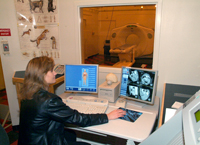New CT Scanner Provides Faster More Detailed Animal Exams
COLLEGE STATION – Small animals are benefiting greatly from a new, state-of-the-art imaging system, helical CT, which allows radiologists at Texas A&M University ‘s College of Veterinary Medicine and Biomedical Sciences to obtain detailed wafer-thin cross-sections of internal anatomy without the need for surgery. With helical CT or “helical CAT scan,” x-ray technology and high-speed computers can produce numerous cross-sectional images of an animal’s anatomy in less than a minute.

The equipment assists veterinarians in the study and diagnosis of animal diseases, injuries and abnormalities. “This is currently the best CT scanner in all of Brazos County ,” said Dr. Anne Bahr, an assistant professor and veterinary radiologist at the College of Veterinary Medicine and Biomedical Sciences. “This is the same kind of CT scanner that is used in human hospitals, but we are easily adapting it for imaging dogs, cats and sometimes birds. We are hoping to remodel the CT exam area and purchase a special table that will enable us to also perform CT exams on horses.”
The technology of the General Electric LightSpeed helical CT scanner allows for more rapid image acquisition and processing than our previous CT machine. Bahr explained, “The circular pathway of the x-ray tube around the patient can be likened to a helix or continuous coil, which results in a much shorter exam time. A very high speed computer processes the digital information obtained, to produce many cross sectional images on a high resolution computer monitor.”
Bahr said, “For just a few examples, we can study brain or spinal cord disease, nasal disease, orthopedic disease and tumors in various parts of the body. We can examine almost any part of the small animal’s body with this equipment.”
Radiologists and technicians can now perform studies of certain body parts that before were difficult to accomplish. “Whereas previously it took such a long time to perform CT studies of the thorax or abdomen, we can now do them on a routine basis,” Bahr said. “We’re also able to do more specialized studies because of the high speed of the machine. For example, we’ve begun performing non-invasive CT angiograms to evaluate blood vessels with just an intravenous injection of contrast medium.”
Another benefit of the high-speed scanner is that some CT exams can now be performed without administering general anesthesia to the animals. “This is a big improvement, especially when dealing either with orthopedic cases involving relatively healthy animals, or possibly with animals too sick to safely anesthetize. Now we can just sedate some of these animals and scan them without the associated risks of general anesthesia,” said Bahr.
The sophisticated computer power of the scanner allows the veterinary professionals to manipulate and to enhance the images. “The computer makes it possible for us to shade, rotate, correlate and measure the anatomy in the CT images,” said Bahr. “We are obtaining more diagnostic information than ever before.”


